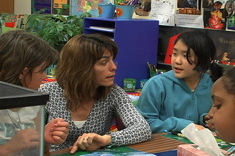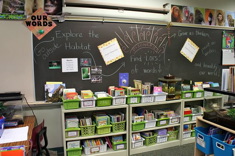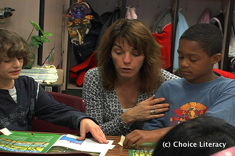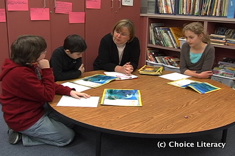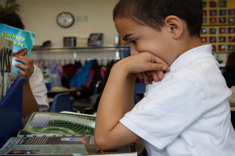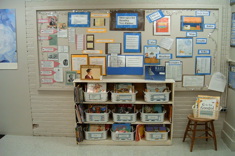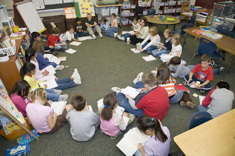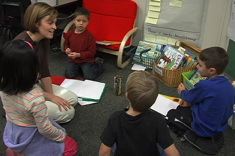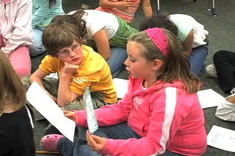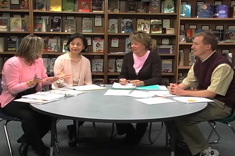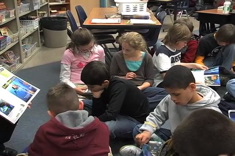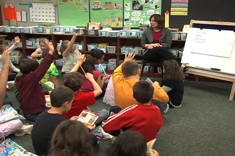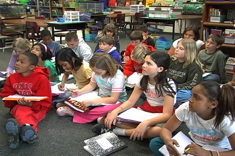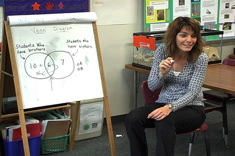Content Literacy
Reading and writing across the curriculum is sparking more interest than ever among teachers and school leaders. Here are the resources you need to build more writing into your math curriculum, more reading and talk into your science program, and especially, how to infuse more nonfiction texts into your teaching throughout the school day.
Latest Content
Our Living Minute: Integrating Nonfiction Study into Morning Meetings
Teachers can accomplish plenty in a minute if they want to add more nonfiction to their day. Learn how from Andrea Smith.
Expedition Mondays: Launching the Week with Nonfiction
Expedition Mondays launch every week in Andrea Smith's classroom with a healthy dose of nonfiction.
Literacy Learning on Presidents Day (BOOKLIST)
Here are some books to spice up your teaching in February on Presidents Day, or any time U.S. presidents come up in your curriculum.
Living Words: Integrating Word Study, Technology, and Content Literacy (Part 1)
Living Words is a quick routine from Andrea Smith that helps students see the power of rich vocabulary for describing the natural world around them.
Writing Like a Scientist: Launching a Scientist’s Notebook
Andrea Smith explains how she launches a unit on science writing with logs, writing samples from scientists, and mentor texts.
Great Books to Share When Studying the Ecosystem (BOOKLIST)
Karen Terlecky shares books for studying the ecosystem in our this booklist.
A Sponge is a Summary
Heather Rader shares a concrete analogy that students (and teachers) love for understanding how summaries work.
Great Nonfiction for Elementary Students
As the quality of nonfiction for students has grown, so have our expectations for using these books with students. Franki Sibberson's presents texts that can help students move beyond "skimming and scanning," and into more in-depth reading.
Rethinking a Study of Nonfiction Writing
Franki Sibberson reflects on her nonfiction writing unit, and realizes she emphasizes research skills at the expense of the craft of nonfiction writing.
Teaching Economics with Children’s Literature
Mandy Robek shares some of her favorite children’s books for teaching economics.
Making Time for Nonfiction Read Alouds
Franki Sibberson considers the issue of selecting nonfiction books for read-aloud time, and in doing so creates one of her popular booklists.
Step by Step: Integrating Nonfiction into Primary Classroom Instruction
Nonfiction texts require different reading skills than fiction, and you can’t introduce nonfiction genres to children too early. Katie DiCesare shares how she moves between whole-class, small-group, and individual instruction to help all her first graders master the text features in nonfiction.
Nonfiction Books for Independent Reading: Moving Beyond Content Connections (BOOKLIST)
Franki Sibberson explains how she boosted the amount of nonfiction texts her grades 4 and 5 students were choosing for independent reading by focusing more on interest than on content connections.
Literary Nonfiction: Models for Writing
Literary nonfiction is emerging as a popular genre. In this booklist, Franki Sibberson shares mentor texts for writing literary nonfiction.
Linking Math and Writing Through Word Problems
In this six-minute video, Franki Sibberson demonstrates how she helps her 3rd and 4th grade students make connections between writing workshop and math problem solving.
Grade Level Team Meeting: Test Preparation
In this video of a 3rd grade team meeting, literacy coaches Janet Scott and Gail Boushey help third-grade teachers think through what is going well with test preparation, and what might be adapted before the tests begin in a few weeks.
Main Ideas in Nonfiction
In this whole-class lesson, 5th grade teacher Karen Terlecky and her students consider how main ideas work in nonfiction texts.
Sports Writing Group Discussion
Franki Sibberson finds sports writing is a powerful motivator for boys in her grades 3-4 classroom.
Nonfiction Word Hunt Part I
Word study and nonfiction reading are combined in Franki Sibberson's nonfiction word hunt activity.
Nonfiction Word Hunt Part II
Franki Sibberson explains the value of the nonfiction word hunt activity.
Test-Taking Skills: Reading Strategies for Word Problems Part I
Question It – Know It – Show It are the keys to test preparation in Andrea Smith's 4th grade classroom.
Test-Taking Strategies Part III: Whole Class Debrief
Andrea Smith’s 4th graders debrief together after a test preparation workshop.
Browse Content By
Type
Category
- Assessment Tools
- Big Fresh Archives
- Booklists
- Choice Numeracy
- Classroom Design
- Common Core
- Community Building
- Conferring
- Content Literacy
- Digital Literacy
- English Language Learners
- Equity
- Family Relations
- Free Samples
- Guiding Groups
- Leadership
- Literacy Coaches
- Mentor Texts
- Minilessons
- New Teacher Mentors
- Podcasts
- Poetry
- Quote Collections
- Reading Strategies
- Self Care
- Struggling and Striving Learners
- Talking and Listening
- Teacher Study Groups
- Teaching Reading
- Teaching Writing
- Word Study and Vocabulary
Author
- Melissa Quimby
- Nawal Qarooni
- Gwen Blumberg
- Julie Cox
- The Lead Learners
- Hannah Tills
- Josie Stewart
- Ruth Metcalfe
- Mallory Messenger
- Becca Burk
- Jodie Bailey
- Vivian Chen
- Mary Brower
- Tiffany Abbott Fuller
- Stephanie Affinito
- Ruth Ayres
- Leigh Anne Eck
- Heather Fisher
- Shari Frost
- Julie Johnson
- Suzy Kaback
- Gigi McAllister
- Shirl McPhillips
- Melanie Meehan
- Cathy Mere
- Debbie Miller
- Tara Barnett and Kate Mills
- Tammy Mulligan
- Dana Murphy
- Bitsy Parks
- David Pittman
- Brenda Power
- Heather Rader
- Matt Renwick
- Mandy Robek
- Christy Rush-Levine
- Gretchen Schroeder
- Jen Schwanke
- Brian Sepe
- Katherine Sokolowski
- Stella Villalba
- Jennifer Vincent
Grade Level
Choice Literacy Membership
Articles
Get full access to all Choice Literacy article content
Videos
Get full access to all Choice Literacy video content
Courses
Access Choice Literacy course curriculum and training


